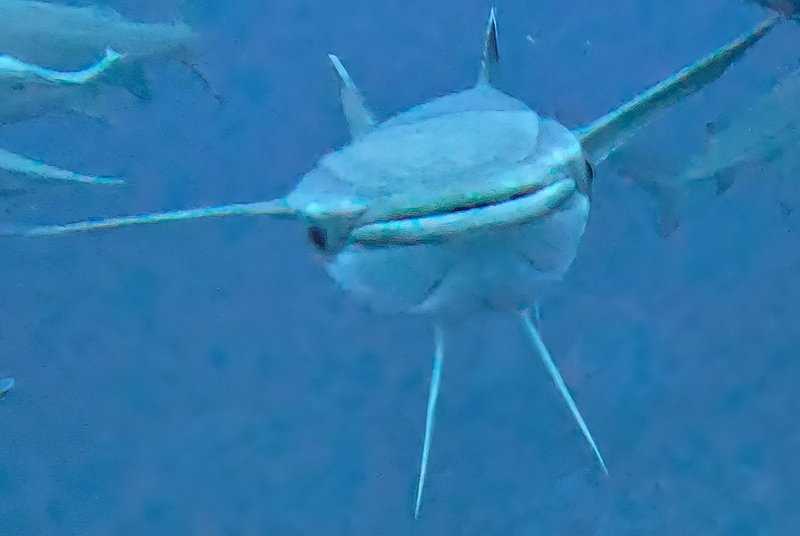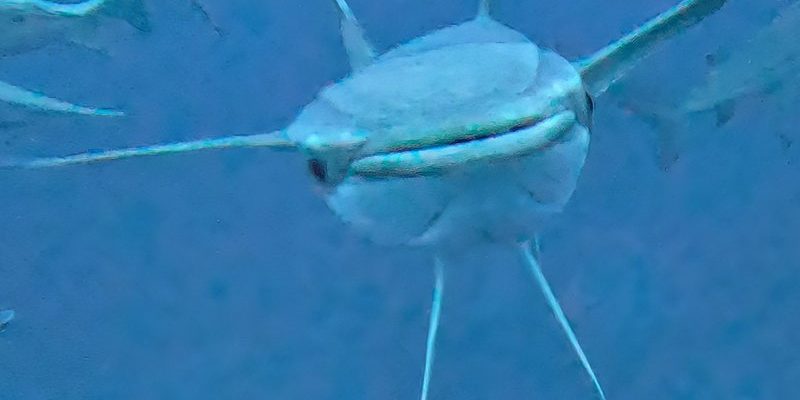
Have you ever heard of the Remora? Imagine a fish that loves to hitch a ride on bigger marine animals. These fascinating creatures, often known as suckerfish, are renowned for their unique ability to attach themselves to larger hosts, like sharks, turtles, and even boats. Think of them as the ultimate travel buddies of the ocean, thriving in a partnership that benefits both parties. This symbiotic relationship not only helps Remoras find food, but also provides protection from predators.
Remoras belong to the family Echeneidae and are characterized by their distinctive flat bodies and a unique suction disc located on the top of their heads. This disc acts like a vacuum, allowing them to cling tightly to their hosts. The relationship is a win-win; while Remoras get a free meal of scraps and protection, their hosts enjoy the benefit of having a few extra cleaners around to help with parasites and debris. Imagine sharing a seat with a friend on a crowded bus—it’s all about making the journey easier.
Where Do Remoras Live?
Remoras inhabit warm waters all around the world, particularly in tropical and subtropical oceans. You might find them near coral reefs, rocky substrates, or even in open water, where they attach to passing bigger fish or marine mammals. These environments provide plenty of opportunities for scavenging on the leftovers from their hosts’ meals. Because of their unique relationship with larger animals, Remoras can travel vast distances, following their hosts from one feeding ground to another.
Interestingly, Remoras are not picky about their travel companions. They can attach to various species, including sharks, rays, and even whales. It’s not uncommon to see a Remora sticking to a massive whale shark, enjoying a ride while munching on plankton or leftover fish bits. This adaptability helps them thrive in different marine environments, making them a common sight in many oceans.
Feeding Habits of Remoras
What do Remoras eat? Their diet mainly consists of small fish, plankton, and leftovers from their host’s meals. They are opportunistic feeders, which means they take advantage of whatever food is available. When attached to a predator like a shark, they get the chance to feast on scraps of larger fish that the shark catches. It’s like finding a buffet next to a busy restaurant—there’s always something to eat!
Another interesting aspect of their feeding habits is their semi-parasitic nature. While Remoras primarily benefit from their relationship with their hosts, they don’t harm them. Instead, they help clean their skin of parasites and dead tissue, which can be quite beneficial for the larger fish. This is a beautiful example of mutualism in nature, where both parties gain from the interaction.
Physical Characteristics of Remoras
Remoras have a streamlined body that allows them to swim efficiently, though they are often seen clinging to their hosts. Their most notable feature is the sucker disc on the top of their heads, which is made of modified dorsal fins. This disc enables them to grip surfaces securely, ensuring they stay attached even while their host is swimming vigorously. In terms of size, Remoras can typically grow anywhere between 2 to 3 feet long, depending on the species.
Coloration can vary among species, but they generally sport a sleek grayish or bluish color with a lighter underside. This coloration provides some camouflage against predators when they are not riding on a larger fish. Just like how some birds have evolved to blend into their surroundings, Remoras have adapted to their environment in ways that enhance their survival.
Life Cycle and Reproduction
Remoras have a fascinating reproductive cycle that showcases their adaptability. They are oviparous, meaning they lay eggs. During the breeding season, females can lay thousands of eggs, which then float to the surface of the water. After hatching, the young Remoras are independent and must find hosts quickly to ensure their survival. This clever strategy allows them to maximize their chances of finding shelter and food right from the start.
As they grow, young Remoras might initially attach to any manageable host, but as they mature, they often become more selective. Larger Remoras tend to stick to larger hosts, like sharks and whales, ensuring they have a safe and plentiful food source. This dynamic is similar to how we often seek out mentors or role models as we grow—our choices evolve as we gain experience.
Table of Interesting Facts
| Scientific Name: | Echeneidae |
| Size: | Up to 3 feet |
| Habitat: | Tropical and subtropical oceans |
| Diet: | Small fish, plankton, scraps |
| Lifespan: | Up to 10 years |
| Reproduction: | Oviparous (egg-laying) |
| Behavior: | Symbiotic attachment to larger marine animals |
The Role of Remoras in the Ecosystem
Remoras play an important role in their ecosystems. By attaching themselves to larger marine animals, they help maintain the health of these hosts by removing parasites and dead tissue. This cleaning service can enhance the overall health of the larger fish, contributing to a balanced marine environment. Think of Remoras as little doctors for their big companions, providing necessary care that keeps the underwater community thriving.
Moreover, they contribute to the food web. As Remoras eat leftover food from their hosts, they indirectly help control fish populations by ensuring that nothing goes to waste. In this way, they support a healthy ecosystem and make sure that resources are utilized efficiently. Every creature, big or small, plays a role in the cycles of life, and the Remora stands out as a unique player in this grand game.
Threats and Conservation
While Remoras are not currently considered endangered, they still face threats from changes in their environment. Overfishing of their larger host species can impact their populations. If sharks or turtles decline due to human activity, Remoras may struggle to find suitable hosts and food sources. This situation highlights how interconnected marine life can be—when one species suffers, others can feel the effects.
Conservation efforts aimed at protecting larger marine animals also benefit Remoras. Initiatives like marine protected areas (MPAs) ensure that these hosts have safe spaces to thrive, which in turn supports the Remoras that rely on them. It’s a reminder of the importance of protecting our oceans and the diverse life within them. Like a web, every thread matters, and when we pull too hard on one, the entire structure can weaken.
Fascinating Behaviors of Remoras
One of the most intriguing behaviors of Remoras is their ability to sense when a suitable host is nearby. They have fairly developed sensory systems that help them detect changes in water currents, which signal the presence of larger fish. This ability is quite remarkable and shows how finely tuned these creatures are to their environment. It’s like having a built-in GPS that helps them navigate their world.
Another interesting aspect of their behavior is how they interact with boats. Sometimes, Remoras will attach themselves to vessels, latching on for a ride above water. While it might seem unusual, this behavior demonstrates their adaptability and willingness to seize opportunistic feeding chances. Imagine spotting a friend on your morning commute and deciding to hitch a ride—Remoras do the same thing in their underwater world!
FAQ
What do Remoras do if their host swims away?
If a Remora’s host swims away, the Remora can detach and search for another host. They are capable swimmers on their own, but they thrive best when they have a larger animal to attach to for protection and food. This adaptability is essential for their survival in the ocean.
Can Remoras attach to any type of fish?
While Remoras can attach to a variety of marine animals, they tend to prefer larger species like sharks or rays. This preference allows them to benefit the most from their interactions, getting food and protection. However, they are opportunistic and will attach to any available host that fits their needs.
How long can Remoras live?
Remoras can live for several years, typically up to ten years in the wild. Their lifespan is influenced by factors such as their habitat, diet, and the availability of hosts. In a healthy marine environment, they tend to thrive and reach their maximum lifespan.
Do Remoras help their hosts in any way?
Yes, Remoras can help their hosts by cleaning them of parasites and dead skin. This mutualistic relationship benefits both parties, as the Remoras get food while the larger animals enjoy healthier skin and reduced parasite loads.
Are Remoras harmful to sharks or other larger marine animals?
No, Remoras are generally not harmful to their hosts. They do not prey on their hosts but instead rely on the leftovers from the host’s meals for sustenance. Their presence can actually be beneficial, providing cleaning services that may improve the health of the host fish.
How do scientists study Remoras?
Scientists study Remoras through various methods, including observational studies and tracking their movements using tags. By understanding their behavior and interactions with hosts, researchers can gather valuable insights into their ecology and role in marine ecosystems.
Can Remoras live in freshwater?
No, Remoras are exclusively marine animals and cannot survive in freshwater environments. Their physiology is adapted to saltwater, which is necessary for their survival. They thrive in warm, tropical, and subtropical oceans across the globe.
What other animals have similar behaviors to Remoras?
Other animals exhibit similar hitchhiking behavior, like the oxpecker bird, which feeds on ticks and parasites from larger mammals in Africa. These relationships often reflect the same principle of mutualism, where both species gain benefits from their association.
How do Remoras reproduce?
Remoras reproduce by laying eggs in the water, where they float to the surface and hatch. After hatching, the young remain independent and must quickly find a host to ensure their survival. This unique reproductive strategy helps them thrive in various marine environments.
What can we do to protect Remoras and their habitats?
To protect Remoras, we should support conservation efforts aimed at preserving marine habitats. This includes advocating for sustainable fishing practices, marine protected areas, and reducing pollution. By safeguarding the ecosystems they live in, we can help maintain healthy populations of both Remoras and their hosts.
Are there different species of Remoras?
Yes, there are several species of Remoras, each with its own specific characteristics and preferred hosts. Some common species include the shortfin Remora and the longfin Remora. While they share many traits, subtle differences in size and behavior distinguish them within their family.

